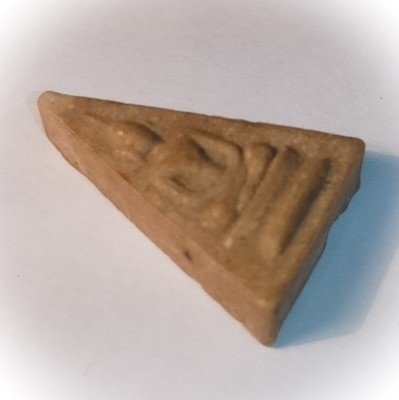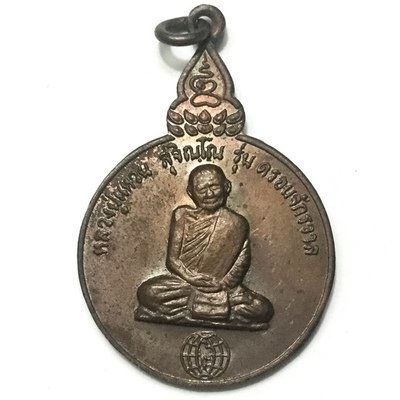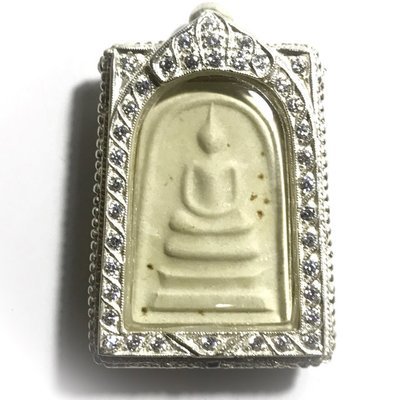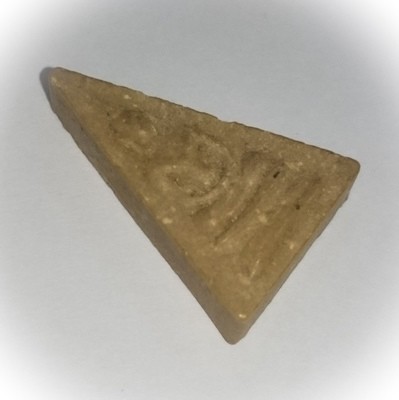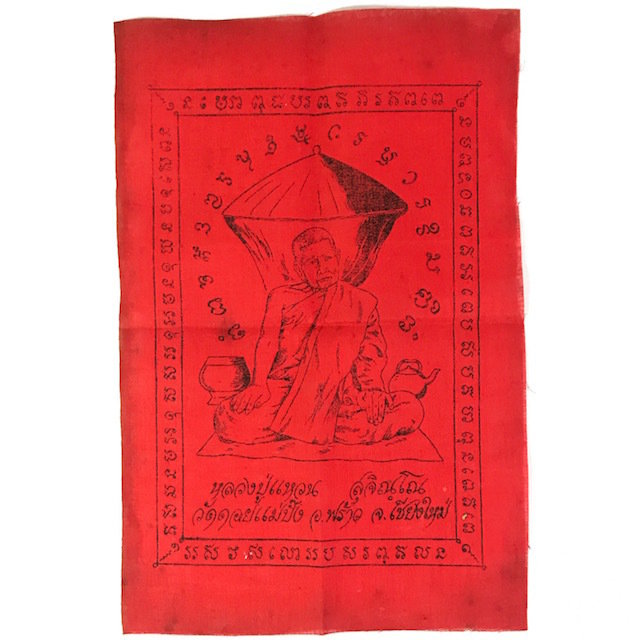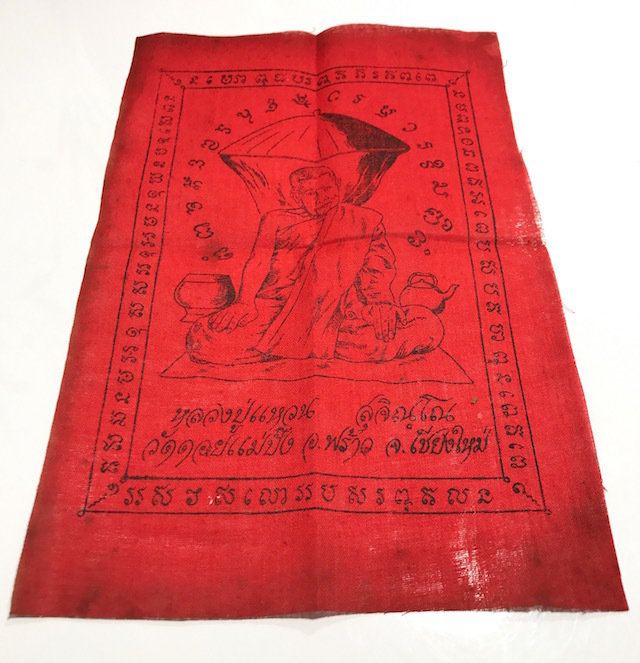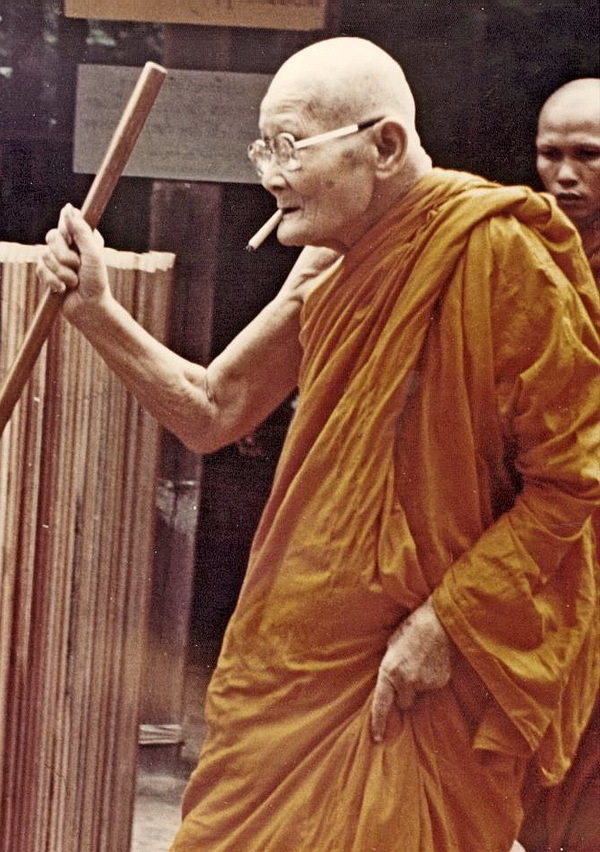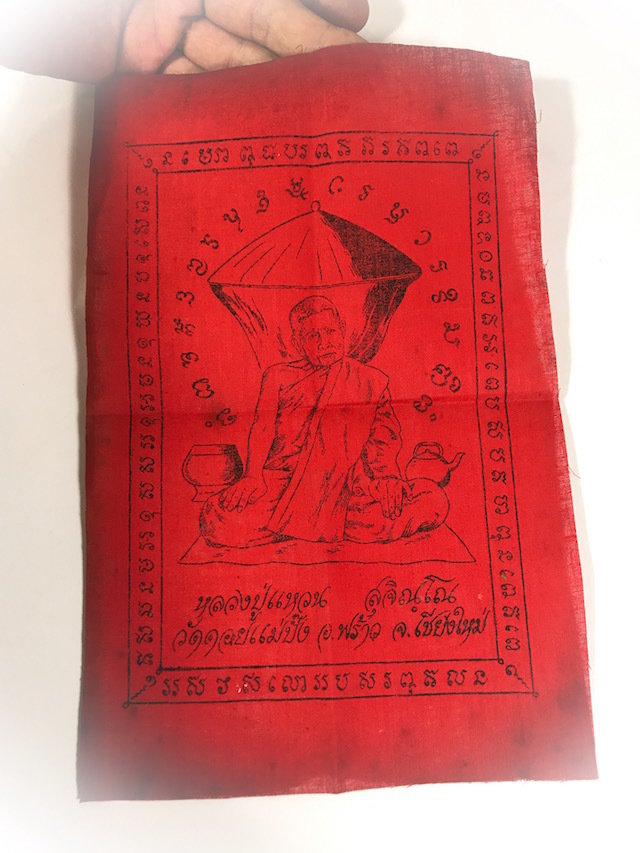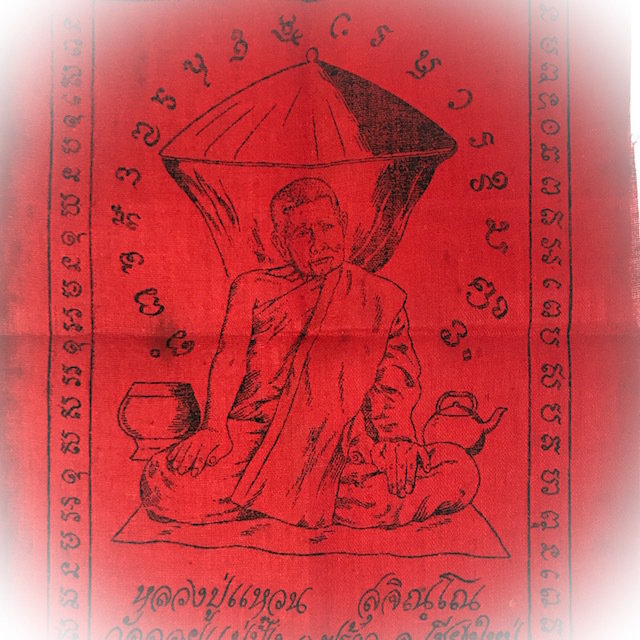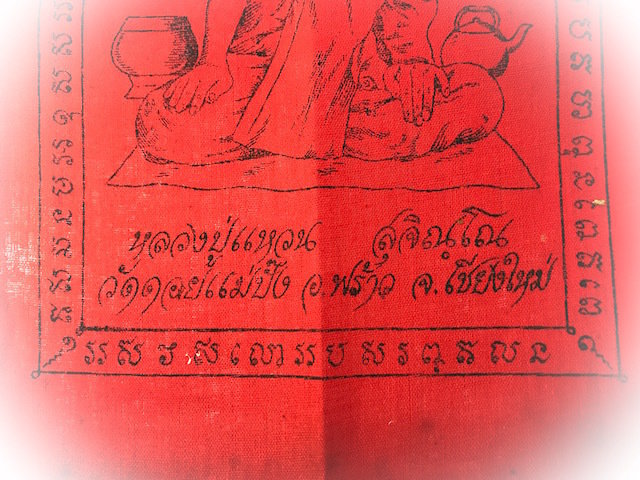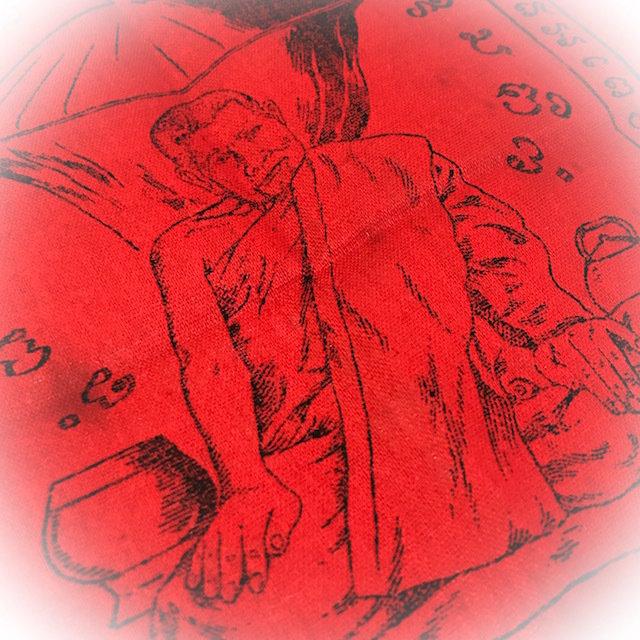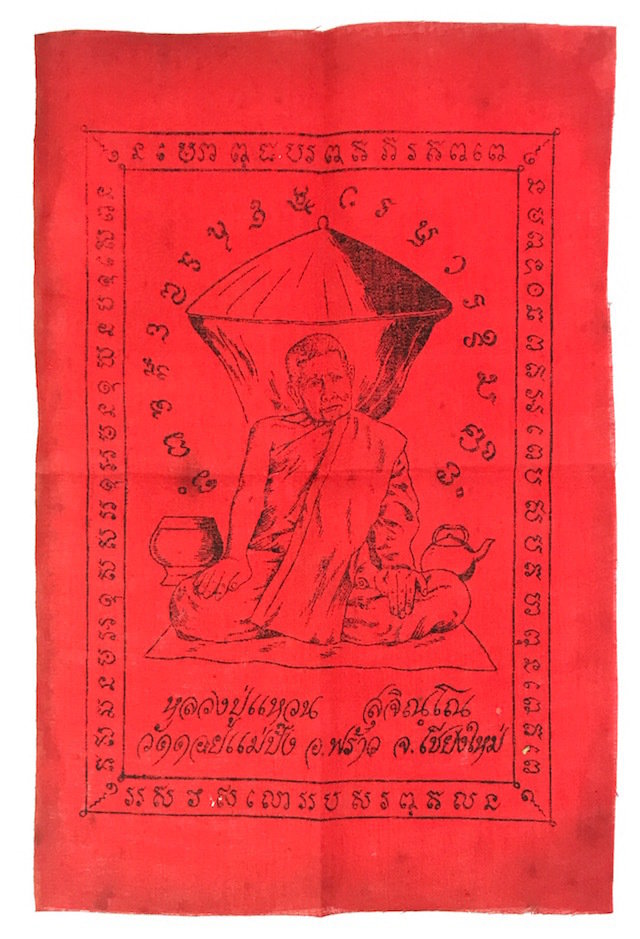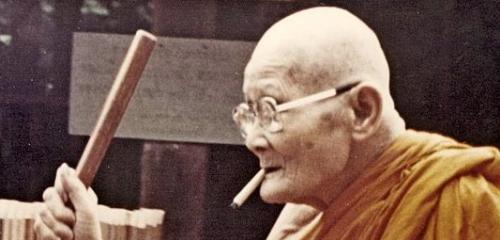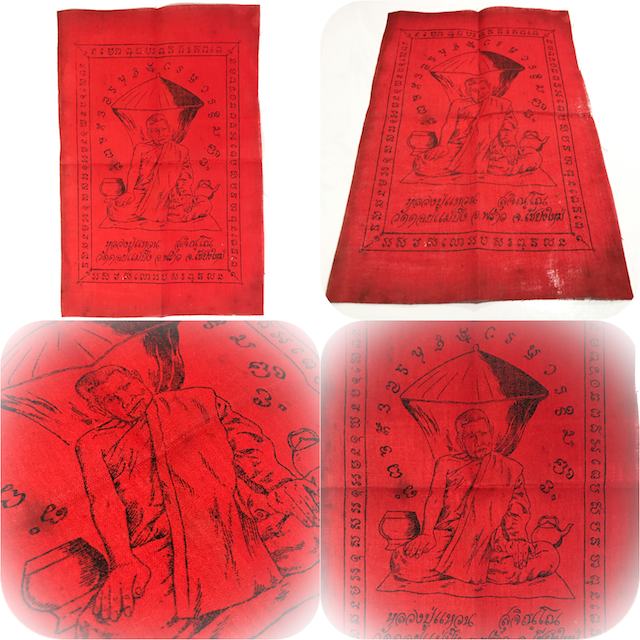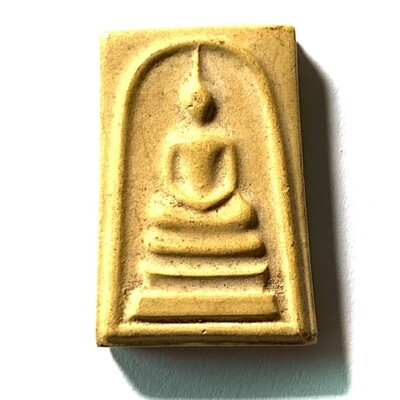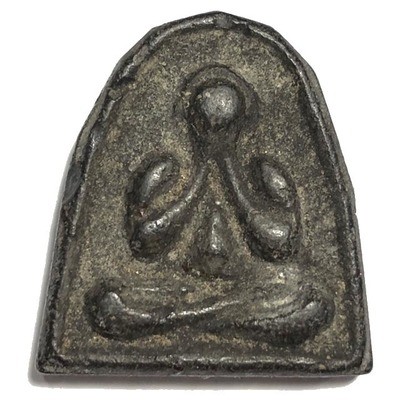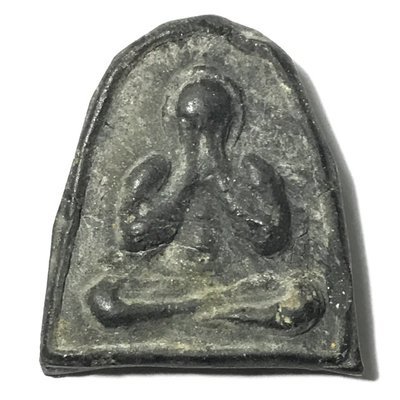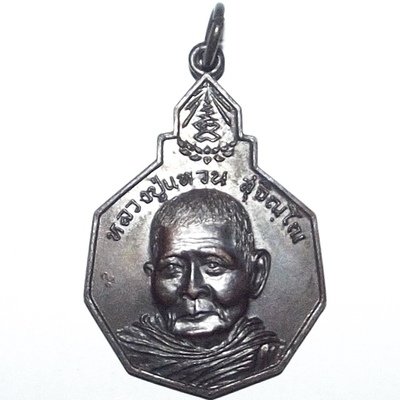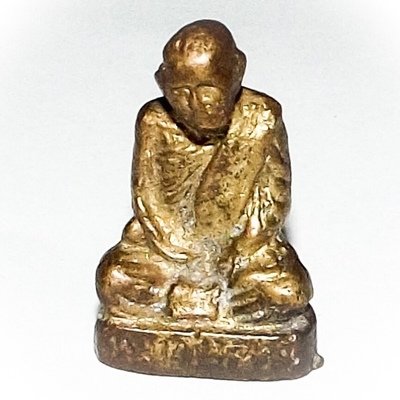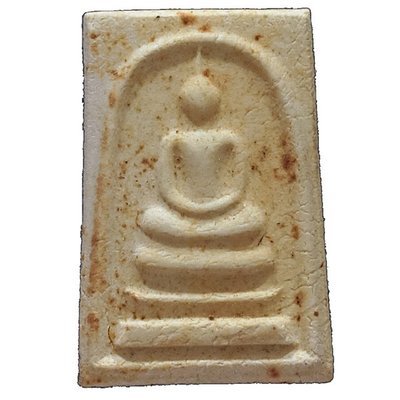A pristinely kept and extremely rare Rian Mangorn Koo Nuea Nava Loha Pim Pised Dtok Sorng Code Ma Wat Pha Nong Lom Run Sao Ha Maha Sethee 5th Lunar Saturday Blessing Ceremony Edition Guru Monk Coin, released in 2543 BE, to raise funds for the Kuti Songk Monks Huts and improve the facilities at the temple of Wat Pha Nong Lom.
This model of Rian Mangorn Koo twin dragons Monk Coin is a very rare Pim Pised (Niyom preferred) and differs from the majority of Rian Mangorn Koo Wat Pha Nong Lom Edition coins in Nava Loha, because of the double code MA stamp. Most coins of the Nava Loha series made for Wat Pha Nong Lom have only a single code Ma Stamp (on the Sangkati chest sash of the robe of Luang Phu), and only the Pim Pised special models received double code stamps. Only very few (unknown number) were distributed with double code stamp, making this not only a sacred, powerful master class amulet, but also a rare collectors piece.
The Rian Mangorn Koo of Luang Phu Hmun is, as are all of his amulets, known for the power of Jaroen Lap Wealth Increasement, and Lucky Fortunes, as well as for their Miraculous Protective Powers. Those born in the year of the dragon love to Bucha this amulet especially, for the obvious reason of the double dragon guardians.
For those with lower budgets, who seek power above collectability and rarity, we recommend to seek the Rian Mangorn Nuea Tong Daeng or Nava Loha single Code Ma, of the same edition, which carries a lower price than this special Nava Loha Pim Pised Gammagarn double code collectors edition model.
Pha Yant Pak Glod 2516 BE Luang Phu Waen Sujjino Wat Doi Mae Pang 11 x 7 Inch Guru Monk Yantra Cloth
Pha Yant Daeng Luang Phu Waen Pak Glod - Red Prajiad Yantra Cloth with an image of the Great Arya Sangha Monk, Luang Phu Waen Sujjino of Wat Doi Mae Pang. The Pha Yant features Luang Phu Waen sitting under his Glod Umbrella, which is the Ubiquitious accessory for all Forest Dwelling Monks on Tudong.
Images of Guru Monks are seen by Devotees as sacred objects which have had direct contact with the Master of Choice. This is of course an obvious relation to faith in the Guru, for those who seek not just an amulet, but a connection with the Guru, in this case, the High Arya Sangha Monk, Luang Phu Hwaen Sujjino.
This Pha Yant can be folded and placed in Pocket (above waist) and is worshiped as Buddhanussati (remembrance of the Guru, and the Triple Gem) and to recieve the protection and blessings of this great Arya Sangha Monk, who was one of the Greatest Master Guru Monks of the last Century, Luang Phu Hwaen Sujjino.
Biography of Luang Phu Hwaen
Luang Phu Waen Sujinno (Thai: หลวงปู่แหวน สุจิณโณ, meaning Venerable Grandfather; 16 February 1887 – 2 July 1985) was one of the longest living students of Pra Ajarn Mun Bhuridatta and was a very popular monk in Thailand. He led the Tudong Forest Tradition life, until the point where he could not physically travel any more and had to settle in a forest monastery in the Chiang Mai region. Luang Phu Waen Sujinno was a monk highly skilled in Samadhi and Dhamma.
He disliked crowded places. He loved to live alone in the forests away from people and urbanized areas just like his teacher, Ajarn Mun Bhuridatta. Some people said that Luang Phu Waen had achieved Arahant level. Luang Por Jao Khun Nor had mentioned that "There is a Pra Arahant, but he lives far away, in the forest". Luang Phu Waen was born on 16 February 1883 (BE 2431) in Tambon Na Pong, Mueang District of Loei, Northeast (Isan) of Thailand to a blacksmith's family.He was named Yan, and had one elder sister.
He ordained as a novice in 1892 at Wat Po Chai in Na Pong at the age of nine to fulfill the wish of his mother when she died while he was five years old. At the age of 13, he became a Naen (novice monk) at Wat Poh Chai, Loei province. He studied with teachers and later ordained as a monk at a temple in Hua Taparn District of Ubon Ratchathani at the age of 21. As a novice monk, he studied the Dharma and Pali, even at that young age he showed exceptional ability. He eventually went Thudong (forest monk) with his teacher, Ajarn Wuhan, travelling from Loei to Ubon Ratchathani, where he remained to learn Dhamma from another teacher, Ajarn Sing. During his Thudong, he met disciples of Ajarn Mun whom he had wanted to further his studies under.
Luang Phu Waen met Ajarn Mun in BE 2462 (at the age of 31) at Bahn Korforest, Udon Thani province. Luang Por Mun Bhuridatta in Udon Thani who taught him the pursuance of a secluded life and the practice of meditation and Dhamma in the jungles. Subsequently Luang Phu Waen travelled widely in the Northeast of Thailand in search of isolated places where he could meditate. His travelling also took him to Bangkok where he met Chao Khun Phra Upali Gunupamacariya of Wat Bowonniwet in 1921 with whom Luang Phu Waen spent several years studying and practising the Dhamma. Later Chao Khun Phra Upali took him to Wat Chedi Luang in Chiang Mai where Luang Phu Waen decided to change from the Maha-Nikaya sect of Buddhism to the stricter Dhammayut sect. Later he went Thudong again with Ajarn Dteu. During his Tudong, he encountered ghosts, wild animals and other dangers but was never afraid despite warnings from local villagers. It was his wish to experience and learn from everything.
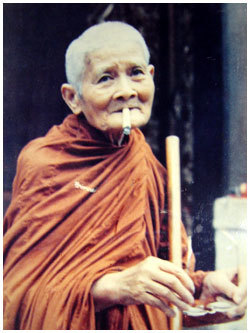
He was told that Ajarn Mun was in Chiang Mai. Luang Phu Waen quickly Thudong to Chiang Mai to look for Ajarn Mun. Finally he met Ajarn Mun and Ajarn Dteu at Wat Chedi Luang. Ajarn Mun officially accepted Luang Phu Waen as his disciple. He studied Dhamma at Wat Chedi Luang. After Ajarn Mun left Wat Chedi Luang for Thudong, Luang Phu Waen also went Thudong in Chiang Mai. He stayed at Wat Huainumrin in Chiang Mai Province for 10 years. During his long stay in Wat Huainumrin, he stayed most of his time in forests and only returning to the temple during the rainy seasons (Khao Phansa).
Luang Phu Waen travelled extensively by foot through jungles and across mountains and ventured to Burma and India where he paid homage to several historic Buddhist sites. However, in 1955 news of a foot injury sustained during his stay in seclusion of Wat Paa Ban Pong in Mae Tang District, Chiang Mai, reached Pra Ajarn Noo Suchitto of Wat Doi Mae Pang who later arranged for Luang Phu Waen to stay in Wat Doi Mae Pang permanently. He resided in Wat Doi Mae Pang until his death in 1985.
Above; Luang Ta Maha Boowa bows to the Great Luang Phu Waen Sujjino during a visit
Luang Phu Waen entered Maharaj Hospital on 15 April 1985 when he was found unable to eat or move and was operated on 4 June 1985 in order to feed him through a tube which was inserted into his stomach. However, complications developed and Pra Ajarn Noo, the abbot of Wat Doi Mae Pang, requested doctors not to perform any more operations as he wanted Luang Phu Waen to rest peacefully. His request was accepted by doctors and the Chiang Mai Governor, Mr. Chaiya Punsiriwong. On 2 July 1985 at 9:54 pm, Luang Phu Waen finally died at the age of 98 years and 5 months after having been in the monkhood for almost 90 years.
He was given a royal-sponsored bathing ceremony at Sala Ang Klaew in Chiang Mai University which was attended by the King and Queen of Thailand as well as the general public. His remains were cremated at a Royal Funeral on 16 January 1986. "Sujinno Building", a 15-level building of Maharat Nakhon Chiang Mai Hospital, was named in his honor.
Famous Saying of Luang Phu Waen
“What is sacred? Everyone has something sacred within themselves. To have been born as a complete human being is already sacred. One can be sacred only from within oneself, and not by any amulet or other so-called sacred objects. Dhamma is sacred, and to have this sacredness, one must have Dhamma within oneself.”
As a very popular monk, Luang Phu Waen is often rumoured to have “sacred amulets” - something which Thai people from all walks of life like to receive from revered monks - for their protective value. People from all over Thailand would often travel to Wat Doi Mae Pang to seek these amulets or other sacred objects from him. He would always give the same answer as the one quoted above.) Wat Doi Mae Pang (Thai: วัดดอยแม่ปั๋ง) is a Buddhist temple in Phrao district, Chiang Mai Province, northern Thailand.
It is some 75 kilometres from the city Chiang Mai,on route 1001 towards Phrao. Local legends say that the road 1001 was built due to Luang Por Waen Sujinno. Legend tells of this monk meditating and floating hundreds of feet into the air. He was seen by helicopter pilot, and the King was said to be so astonished, that he realized a road must built to this holy place.
The locals have variations of this tale but any tourists in the area will hear this as the reason for Road 1001 being built. Its greatest claim to fame is that it was the home to Luang Por Waen Sujinno. Many of the buildings are of wooden construction, including the viharn and a hermit's cell called Rong Yang Kiles or Rong Fai. Relics of Luang Por Waen Sujinno include his dwelling hut, a picture in the pavilion that shows him meditating, and a square-shaped, spire-roofed museum with his ashes, a wax model of the monk, and his personal effects.
Kata Luang Phu Waen Sujjino
PUTTŌ ARANANG TAMMŌ ARAHANG SANGKŌ ARAHANG - ARAHANG PUTTŌ ARAHANG TAMMŌ ARAHANG SANGKO
พุธโธ อรหัง ธัมโม อรหัง สังโฆ อรหัง อรหัง พุทโธ อรหัง ธัมโม อรหัง สังโฆ
